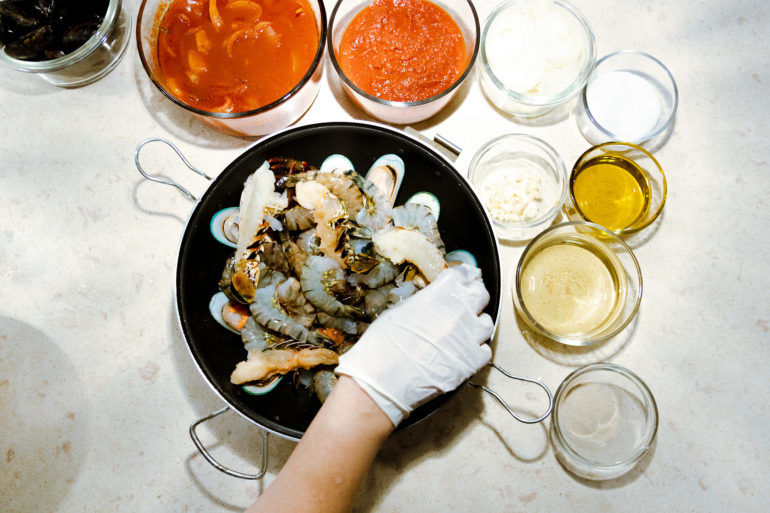Summer in Algarve is Portugal’s perfect vacation destination—sandy beaches, sapphire blue ocean and delicious meals created from the freshest ingredients. With roughly 200 kilometers of coastline, it’s no surprise that fish and seafood are the main ingredients in the Algarve cuisine, including the region’s most famous dish, cataplana. Avó Rosa Bandeira stepped up to the challenge of showing us how she creates this traditional meal and she gave us a history lesson in the process.
“What many people don’t realize is that word cataplana refers to both the stew and the pot in which it is prepared.” The pot, which is unique to the region, was traditionally made out of hammered copper. The use of copper allowed excellent heat conductivity throughout the cataplana, giving a unique and incomparable flavour to the delicacies made in it. Shaped like a clam, the domed lid latches on to the bottom to seal it closed, so it functions like a Dutch oven, encouraging a steaming effect. “Cooking in the cataplana makes the flavours richer. The juices don’t just evaporate into the air, they are continuously sinking back into the food, creating a succulent liquid in the bottom.”
Although the exact origin of the cataplana is unknown, many believe that it originated during the eighth century under Moorish occupation and that it is the Portuguese equivalent of the tagine—a similar cooking vessel from northern Africa.
“In the past, fishermen would use the cataplana as a lunchbox, filling at home with the essentials like garlic, onions, olive oil, and the vegetables. When it was time to eat, they would add their catch and simmer everything in the same pot directly over a fire. Many times, a hole was made in the ground where the cataplana was placed over embers and covered with sand.”
Although a typical cataplana is made with any combination of seafood—prawns, clams, mussels, fish, squid, octopus—Rosa suggests using your imagination. “Add any combination that you like—mussels and spicy chouriço; squid and cured ham; squid and rabbit; octopus and sweet potato; pork and clams; or make it vegetarian—all are superb variations. This is truly the easiest pot to cook in. Create a refogado (garlic and onion sautéed in olive oil) in the bottom of the pan, add your meat and vegetables, pour in some liquid (wine, water, broth or a mixture of all three), clamp it, bring it to a simmer and leave it on a medium-low heat until your meat is cooked.”
It wasn’t long before we were at the table enjoying Avó Rosa’s Seafood Cataplana, served with a chilled bottle of Alvarinho and plenty of crusty bread to mop up the juices at the end. It was delicious, and I was anxious to try the recipe at home, but there was a small problem—I don’t own a cataplana. “If you don’t have a cataplana you can make this recipe in a Dutch oven, wok or any heavy-bottomed pot with a fitted lid but try your best to find one. Many Portuguese grocers in the Toronto area sell them and you can definitely find them online.”
I’m looking forward to having the taste of the Algarve in my kitchen very soon.
Cataplana
SERVES 6 | COOK TIME 1 HR
INGREDIENTS
- 1 onion
- 1 dl olive oil
- 2 cloves garlic
- 1/2 red pepper
- 300 g shrimp
- 1 lobster (approx. 500 g)
- 1 dl white wine
- 1 tbsp tomato paste
- 500 g clams
- 200 g half-shelled mussels
- coriander (finely chopped)
- salt q.b.
- piri piri sauce
INSTRUCTIONS
- Place the lobster, shrimp or mussels in the bottom of the cataplana pan.
- Cut the onions, garlic and peppers into thin slices.
- Add the onions, garlic, and olive oil to a pan and cook until the onions have browned a bit.
- Add red pepper and sauté.
- Add the wine and the tomato paste, season with salt and piri piri sauce.
- Pour the sauce over the seafood.
- Close the cataplana and cook for ten minutes.
- Remove the cataplana from the heat.
- Add the clams, close the cataplana, let it cook for five minutes shaking it from time to time.
- Finally, season with salt and pepper if necessary and add the coriander.
- Serve immediately with white rice or toasted bread.
WORDS: DAVID GANHÃO
RECIPE: ROSA BANDEIRA
PHOTOS: FIN CHRISTOFORIDIS









